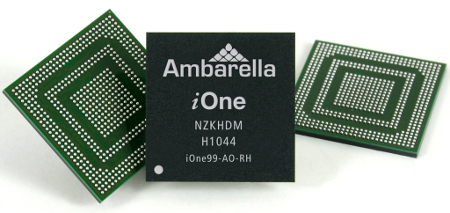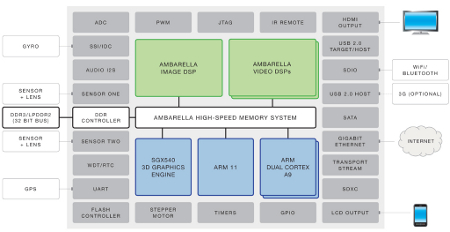Tri-core SoC aims for 3D/HD Android cameraphones
Dec 22, 2010 — by Eric Brown — from the LinuxDevices Archive — 11 viewsAmbarella is sampling a Cortex-A9 based system-on-chip intended to bring Android phones 1080p60 resolution and 3D video capabilities. By combining a dual-core, 1GHz Cortex-A9 processor, a 533MHz ARM11 processor, image and video DSPs, and a 3D graphics engine, the iOne SoC offers multistream encoding for live video streaming, simultaneous still photography and HD video recording, and HD telepresence, says the company.
It's rare to read a review of an Android phone that offers unmitigated praise for the camera — or as is increasingly the case, the cameras. Android itself has been slow to offer comprehensive camera support, only officially supporting dual cameras in the most recent Android 2.3 release. Video, meanwhile, is rarely as smooth as vendors claim.
Sensing an opportunity, Ambarella — which bills itself as a leader in low-power, high-definition video compression and image processing semiconductors — has introduced an all-purpose Android system-on-chip (SoC) that supplies its own ARM11 processor dedicated to camera work. With its dual 1GHz, ARM Cortex-A9 cores and dedicated ARM11 and DSPs, the iOne SoC is kind of like a souped up Nvidia Tegra 2 with extra multimedia firepower.

Ambarella iOne SoC
Judging from the block diagram below, the SoC also provides a dedicated image processing digital signal processor (DSP), as well as one or more video DSPs. As is typical on Cortex SoCs, the iOne supplies an Imagination Technologies Powervr SGX540 3D graphics engine, said to support OpenGL ES 2.0 and HD GUI requirements.
The iOne combines these processors with the dual 1GHz Cortex-A9 cores via a single high-speed memory bus. The iOne requires only a single DDR3 x32 DRAM chip "for extremely low power operation and low total system cost," says the company.

iOne block diagram
(Click to enlarge)
The SoC supports full-duplex encode and decode of HD 1080p30 H.264 video, and is claimed to offer the industry's first low-power 1080p60 decoder, enabling full 3D HD decoding on a mobile platform. An HDMI 1.4 transmitter supports 3D HDTV output and display, says the company.
The iOne also enables simultaneous still photography and HD video recording, says Ambarella. The SoC is said to support up to 32-megapixel still image processing while at the same time capturing five-megapixel images at 30 frames per second. Combining the iOne with Ambarella's optional S3D pre-processor enables stereoscopic HD video and still image capture, says the company.
The iOne's multi-stream capability is said to enable an Android device to encode full HD 1080p30, while simultaneously uploading a second such video stream to the Internet over Wi-Fi. This would provide for fast, almost "live" uploads to YouTube or other sites, as well as videoconferencing and telepresence capabilities, says the company.
Additional features provided by the iOne SoC are said to include:
- support for leading video formats like H.264, MPEG-2, DivX, and VC-1
- high ISO capability with excellent low-light performance
- advanced noise reduction including MCTF (Motion-Compensated Temporal Filtering) for minimal motion blur
- on-device HD video editing with hardware acceleration
- Electronic Image Stabilization (EIS) with CMOS sensor rolling shutter correction
Basic hardware specs for the iOne, in part derived from the block diagram above, include:
- Processors:
- dual-core 1GHz Cortex-A9
- 533MHz ARM11
- PowerVR SGX540 3D GPU
- Ambarella image DSP
- Ambarella video DSPs
- Wireless interfaces — 802.11n, GPS, Bluetooth, FM, Mobile TV
- Additional interfaces including:
- dual CMOS sensor inputs (SLVDS/MIPI/HiSPi/parallel)
- gigabit Ethernet
- SATA
- 2 x USB 2.0
- S/PDIF
- transport stream and analog video out
- SD and flash controller
- LCD
- IR remote
- SSI/IDC (Gyroscope)
- GPIO, UART, JTAG, PWM
Stated Fermi Wang, Ambarella CEO. "The iOne will fundamentally change the way consumers capture, create and share visual content."
Availability
The iOne SoC is sampling now to early access customers, supporting Android, says Ambarella. More information may eventually appear on Ambarella's website.
This article was originally published on LinuxDevices.com and has been donated to the open source community by QuinStreet Inc. Please visit LinuxToday.com for up-to-date news and articles about Linux and open source.